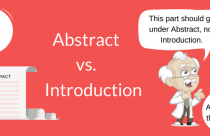How to Write the Methods Section of a Scientific Article

What Is the Methods Section of a Research Paper?
The Methods section of a research article includes an explanation of the procedures used to conduct the experiment. For authors of scientific research papers, the objective is to present their findings clearly and concisely and to provide enough information so that the experiment can be duplicated.
Research articles contain very specific sections, usually dictated by either the target journal or specific style guides. For example, in the social and behavioral sciences, the American Psychological Association (APA) style guide is used to gather information on how the manuscript should be arranged. As with most styles, APA’s objectives are to ensure that manuscripts are written with minimum distractions to the reader. Every research article should include a detailed Methods section after the Introduction.
Why is the Methods Section Important?
The Methods section (also referred to as “Materials and Methods”) is important because it provides the reader enough information to judge whether the study is valid and reproducible.
Structure of the Methods Section in a Research Paper
While designing a research study, authors typically decide on the key points that they’re trying to prove or the “cause-and-effect relationship” between objects of the study. Very simply, the study is designed to meet the objective. According to APA, a Methods section comprises of the following three subsections: participants, apparatus, and procedure.
How do You Write a Method Section in Biology?
In biological sciences, the Methods section might be more detailed, but the objectives are the same—to present the study clearly and concisely so that it is understandable and can be duplicated.
If animals (including human subjects) were used in the study, authors should ensure to include statements that they were treated according to the protocols outlined to ensure that treatment is as humane as possible.
- The Declaration of Helsinki is a set of ethical principles developed by The World Medical Association to provide guidance to scientists and physicians in medical research involving human subjects.
Research conducted at an institution using human participants is overseen by the Institutional Review Board (IRB) with which it is affiliated. IRB is an administrative body whose purpose is to protect the rights and welfare of human subjects during their participation in the study.
Literature Search
Literature searches are performed to gather as much information as relevant from previous studies. They are important for providing evidence on the topic and help validate the research. Most are accomplished using keywords or phrases to search relevant databases. For example, both MEDLINE and PubMed provide information on biomedical literature. Google Scholar, according to APA, is “one of the best sources available to an individual beginning a literature search.” APA also suggests using PsycINFO and refers to it as “the premier database for locating articles in psychological science and related literature.”
Authors must make sure to have a set of keywords (usually taken from the objective statement) to stay focused and to avoid having the search move far from the original objective. Authors will benefit by setting limiting parameters, such as date ranges, and avoiding getting pulled into the trap of using non-valid resources, such as social media, conversations with people in the same discipline, or similar non-valid sources, as references.
Related: Ready with your methods section and looking forward to manuscript submission? Check these journal selection guidelines now!
What Should be Included in the Methods Section of a Research Paper?
One commonly misused term in research papers is “methodology.” Methodology refers to a branch of the Philosophy of Science which deals with scientific methods, not to the methods themselves, so authors should avoid using it. Here is the list of main subsections that should be included in the Methods section of a research paper; authors might use subheadings more clearly to describe their research.
- Literature search: Authors should cite any sources that helped with their choice of methods. Authors should indicate timeframes of past studies and their particular parameters.
- Study participants: Authors should cite the source from where they received any non-human subjects. The number of animals used, the ages, sex, their initial conditions, and how they were housed and cared for, should be listed. In case of human subjects, authors should provide the characteristics, such as geographical location; their age ranges, sex, and medical history (if relevant); and the number of subjects. In case hospital records were used, authors should include the subjects’ basic health information and vital statistics at the beginning of the study. Authors should also state that written informed consent was provided by each subject.
- Inclusion/exclusion criteria: Authors should describe their inclusion and exclusion criteria, how they were determined, and how many subjects were eliminated.
- Group characteristics (could be combined with “Study participants”): Authors should describe how the chosen group was divided into subgroups and their characteristics, including the control. Authors should also describe any specific equipment used, such as housing needs and feed (usually for animal studies). If patient records are reviewed and assessed, authors should mention whether the reviewers were blinded to them.
- Procedures: Authors should describe their study design. Any necessary preparations (e.g., tissue samples, drugs) and instruments must be explained. Authors should describe how the subjects were “manipulated to answer the experimental question.” Timeframes should be included to ensure that the procedures are clear (e.g., “Rats were given XX drug for 14 d”). For animals sacrificed, the methods used and the protocols followed should be outlined.
- Statistical analyses: The type of data, how they were measured, and which statistical tests were performed, should be described. (Note: This is not the “results” section; any relevant tables and figures should be referenced later.) Specific software used must be cited.
What Should not be Included in Your Methods Section?
Common pitfalls can make the manuscript cumbersome to read or might make the readers question the validity of the research. The University of Southern California provides some guidelines.
- Background information that is not helpful must be avoided.
- Authors must avoid providing a lot of detail.
- Authors should focus more on how their method was used to meet their objective and less on mechanics.
- Any obstacles faced and how they were overcome should be described (often in your “Study Limitations”). This will help validate the results.
According to the University of Richmond, authors must avoid including extensive details or an exhaustive list of equipment that have been used as readers could quickly lose attention. These unnecessary details add nothing to validate the research and do not help the reader understand how the objective was satisfied. A well-thought-out Methods section is one of the most important parts of the manuscript. Authors must make a note to always prepare a draft that lists all parts, allow others to review it, and revise it to remove any superfluous information.










m so confused about ma research but now m okay so thank uh so mxh
Mil gracias por su ayuda.